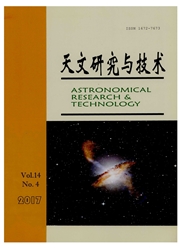

 中文摘要:
中文摘要:
500m口径球面射电望远镜(Five-hundred—meter Aperture Spherical Radio Telescope,FAST)是一个超大口径的可动望远镜,有三项技术创新,一是选址,二是轻型馈源索支撑,三是主动反射面。在主动反射面上,单元面板的面型和面板的出厂加工精度对电磁波在反射面的汇聚有很大影响。FAST主反射面由4600块三角形反射面板拼接而成,每块面板为边长11m三角形,这对FAST反射面面板的测量技术提出了更高的要求。摄影测量直接在影像上进行量测,无需接触物体本身;所摄影像信息丰富,可以从中获得所研究物体的大量几何信息和物理信息;适用于大范围、多目标测量,效率高。目前世界上最大的射电望远镜,如GBT和ARECIBO都是采用摄影测量技术进行反射面面形检测。在对现有的面型检测技术调研并试验后,提出基于数字近景摄影测量的方法,对FAST反射面11in单元面板的面型进行检测,数分钟完成反射面板面型的一次检测,测量精度达到2.5mm,经过调整后的单元面板的面型精度达到了3.0mm,结果表明摄影测量应用于FAST反射面单元面板面型检测是可行的。
 英文摘要:
英文摘要:
The FAST (Five hundred meter Aperture Spherical Radio Telescope) will be the largest radio telescope in the world. There are three outstanding technological innovations in the FAST project: the unique Karst depression as the site for antenna, the light-weight focus cabin driven by cables and servomechanisms, and the active main reflector. When we set the main reflector, the surface shape (including errors in manufacturing) of each of its panels has significant influence on the convergence of electromagnetic waves. It is necessary to measure the surface shape so that it can be set correctly. The FAST main reflector consists of 4 600 triangular panels spliced together, each of which has a side length of 11 meters. The large sizes require certain fine technique for measuring surface shapes. In the photogrammetry a measured object is not physically
 同期刊论文项目
同期刊论文项目
 同项目期刊论文
同项目期刊论文
 期刊信息
期刊信息
